Shared posts
Someone Asked about Ayahuasca's Sustainability
Dear X: You've hit on one of my sore points. In terms of ayahuasca use, god forgive me, but I am responsible for a lot of this. It would have happened without me, but would have taken 20 more years to start and might not have evolved as it has since I invented Alan Shoemaker and he invented Iquitos.
No, ayahuasca is not sustainable the way it is going. Not by a long shot. In the old days, I'd just cut enough vine for Julio and I for ceremony. These days, with sometimes 12 guests, we need 20 pounds of vine. That's a lot. That might be 30 feet of 7-year-old vine. Now my team has planted hundreds of vines and within the next few years they will be able to harvest a ton or more. BUTTT.....they are being asked for 20 sacks a month by the ayahuasca retreat centers in and around nearby Jenero Herrera and in Iquitos--about 1000 pounds. So for the wild ayahuasca, they are stripping it all for miles around. And they're just a few of the people collecting to provide the retreat requirements. Still, people will plant and there will be enough. But wild animals and wild fruit and wild vines have a strength that fostered animals/fruit/vines just don't have. So if your real question is why are these novices opening ayahuasca centers when they don't have the right experience, well, I'm with you. I have met lots of people who have ceremonial centers who have never spent a day in the jungle. I'm not happy about that but I'm not the boss of the world. So I'm hoping for the best, but not necessarily expecting it.
If I had not responded simply out of anger, I might have added that the value to the lives of those who have taken ayahuasca has often been immeasurable, and those changed/charged humans then go back to daily life and probably positively affect those around them. So while I'm not thrilled personally when someone with little experience decides to cut primary forest to build a camp that will probably be abandoned in a year or three, and then contacts people like my team to provide them the medicine they need for those camps, the better half of me understands that the net result, while bad for the jungle, might be very good for the world at large. Bit of a conundrum, but if people are a bit more careful, not one that cannot be fixed. Those people who open camps should plant ayahuasca before they ever start cutting forest. That might give vines several months head start on taking hold. And ayahuasca will grow quickly once it's taken hold. Then those people would be less dependent on people who know the forest to collect wild vine--a process which by it's nature disturbs the forest and habitat near those vines. That would certainly be a beginning to correcting the balance.
Horde of space GIFs
4chan's worksafe GIF board– a treasure trove of excellent content before it hits the social media tracts –has a great thread of space GIFs up now. I've selected a few of the best here.
There are a couple hundred more in the full thread. Put your face to the GIF firehose that is my Tumblr.
Aaron's Law
The search for a genetic killer
 The medical examiner for the Sandy Hook shooting has requested a genetic analysis of killer Adam Lanza. Following this, a powerful editorial in the science magazine Nature has condemned the move suggesting it is “misguided and could lead to dangerous stigmatization.”
The medical examiner for the Sandy Hook shooting has requested a genetic analysis of killer Adam Lanza. Following this, a powerful editorial in the science magazine Nature has condemned the move suggesting it is “misguided and could lead to dangerous stigmatization.”
But the request to analyse the DNA of Lanza is just the latest in a long line of attempts to account for the behaviour of individual killers in terms of genetics.
Perhaps the first attempt was for a case that bears more than a surface resemblance to the Sandy Hook shooting. In 1998, a 15-year-old high school student called Kip Kinkel killed both of his parents before driving to school and shooting 24 students, one of whom died.
In his trial a child psychiatrist argued that Kinkel had “genetic loading” that made him susceptible to mental illness and violence.
His appeal also relied upon this angle. His lawyer argued that “owing to a genetic predisposition, and therefore through no conscious fault of his own, the defendant suffers a mental illness resulting in committing his crimes.”
Perhaps for the first in decades, an appeal to genetics was used in an attempt to explain the killer’s behaviour.
The genetic arguments became more sophisticated with the trial of serial killer Cary Stayner where a psychiatrist and geneticist presented a genealogy of the his family showing how mental illness and violence ‘ran through the family’.
By the time of the trial of murderer Stephen Mobley, the defence based part of their case on molecular genetics – suggesting that Mobley had a version of the MAOA gene that made him susceptible to violence.
It’s worth noting that none of these appeals to genetics have been successful in the courtroom but it’s interesting that in light of the tragic events in Sandy Hook there has been, yet again, a look towards genetics to try and make sense of the killer – this time presumably based on the yet more advanced technology of whole DNA sequencing.
On this occasion, however, the reasons seems less related to issues of legal responsibility and more for scientific motivations, supposedly to better understand the ‘DNA of a killer’.
As the Nature editorial makes clear, this is foolish:
There is no one-to-one relationship between genetics and mental health or between mental health and violence. Something as simple as a DNA sequence cannot explain anything as complex as behaviour.
However, it shows an interesting shift away from the courtroom genetics of past incidents to a ‘public health’ approach, where, as sociologist Nikolas Rose has noted, the justification is given…
…not in the language of law and rights, but in terms of the priority of protecting “normal people” against risks that threaten their security and contentment. Biological factors are merely one set of factors among others predisposing individuals to antisocial conduct, and “therapeutic interventions” are proposed for the good of both the individual and society.
There is a valuable science of understanding how genetics influences violent behaviour but analysis of individual killers will tell us very little about their motivations.
It does, however, reflect a desire to find something different in people who commit appalling crimes. Something that is comprehensible but distinct, alien but identifiable.
This may give us comfort, but it does little to provide answers. In the midst of tragedy, however, the two can easily be confused.
Link to Nature editorial.
Sweden Ends Forced Sterilization Of Transgender People

Nova Colliander with her 'intergender' partner Vio Szabo.
Sweden has taken a long-overdue step to end the requirement that transgender people who wish to update their sex identification on legal documents undergo sex reassignment surgeries that require them to sacrifice their ability to have children. This is thanks to a court judgment that now applies to the whole country circumventing the sterilization law, which is set to be rewritten and removed from the books by July 1, 2013. Sixteen other countries in the European Union require transgender citizens to undergo the surgery, which many trans people do not want or require.
Last year, liberal and moderate members of Sweden’s Parliament were prepared to change the law, but were initially blocked by conservative political groups led by the Christian Democrat Party. Nova Colliander, a trans woman opposed to the sterilization requirements, expresses the pain of sacrificing her reproductive ability and her bitterness that it’s taken so long to change the policy [edited via Google Translate]:
COLLIANDER: It was an assault, a rape. The state gave an ultimatum I had to accept. The alternative was to die, which I felt so strongly. I do not know how many wills I wrote as a child… I am terribly disappointed that it took so terribly long.
Being transgender is considered embarrassing and unimportant in society. They would rather hide us, it’s hard to even talk about us. Therefore, it has taken time… It’s lucky that I can feel joy for others. Otherwise I would have been driven to madness by the bitterness.
Sweden has an infamous history of eugenic sterilization that took place between 1934 and 1976, with over 21,000 forcibly sterilized and another 6,000 coerced into a “voluntary” sterilization. A governmental inquiry into the misdeeds of the past ended in 2000 that paid out damages to the victims. Sex identity changes remained the last form of forced sterilization in the nation, but it remains unclear if the government will consider a new set of reparations.
 |
 |
Oregon Insurance Companies Can No Longer Discriminate Against Transgender People
 Last month, the Oregon Insurance Division of the state’s Department of Consumer and Business Services quietly issued a bulletin that constitutes a monumental new protection for transgender people in the state. In 2007, Oregon passed a law prohibiting discrimination against LGBT people, and the new bulletin dictates that as such, it is illegal for insurance companies to deny coverage to trans people or refuse to cover their medically necessary health care. Here is a list of actions that could constitute discrimination based on gender identity (actual or perceived) for all private insurers in Oregon, via PQ monthly:
Last month, the Oregon Insurance Division of the state’s Department of Consumer and Business Services quietly issued a bulletin that constitutes a monumental new protection for transgender people in the state. In 2007, Oregon passed a law prohibiting discrimination against LGBT people, and the new bulletin dictates that as such, it is illegal for insurance companies to deny coverage to trans people or refuse to cover their medically necessary health care. Here is a list of actions that could constitute discrimination based on gender identity (actual or perceived) for all private insurers in Oregon, via PQ monthly:
- Denying, cancelling, limiting, or refusing to renew an insurance policy.
- Requiring different rates or premiums.
- Classifying “gender identity disorder” or “gender dysphoria” (GI/GD) as a disqualifying pre-existing condition.
- Denying coverage for a procedure that is provided for the treatment of other conditions of illness (such as hormone therapy, mastectomy, or vocal training).
- Categorically denying coverage of GI/GD.
- Denying mental health coverage for GI/GD-related issue in adults.
- Denying sex-specific care (such as pap smears and prostate exams).
In a 2010 study, 19 percent of trans people reported being refused medical care, 28 percent postponed medical care due to discrimination, and 48 percent reported that they simply could not afford treatment. Bridging this inequity is essential for helping members of the trans community access the same basic level of health care as the general public.
Read the full bulletin, or learn more about filing a complaint.
 |
 |
Welcome to the Dawn of the Post-Apocalypse
 Welcome to 2013.
Welcome to 2013.
We have lived through Y2K, countless Rapture dates, the hadron collider, 06/06/06, and the dreaded 2012. Everything that fear mongers have warned would end us turned out to be nothing more than smoke.
WE ARE NOW POST APOCALYPSE. Let’s start living like it.
Live like you, your children, and your children’s children will be here tomorrow.
Here is my recipe for maximizing the New Year bump.
- SCREW THE NEW RESOLUTIONS: I do not start any new resolutions or habit changes. Doing so right now more or less psychically links you to everyone elses new years resolutions. At first this seems like a great idea and it would be if it did not also psychically link you to the 95% of people that fail at keeping their resolution within two months.
- GET BACK ON TRACK: The holidays tend to take us off track. I started a new diet plan at the beginning of December and lost 12 pounds. During the last two weeks I have basically only focused on not gaining any of it back during the holidays, and I have been successful in that. Today I resume my normal diet.
- REVISIT, AND DOUBLE DOWN: I like to re-read an influential book at New Years. I have re-read Four Hour Work Week for three years now. Strategic Sorcery would not be here without it. While not a great time to start something new, I do find New Years a great time to remind ourselves of things and to double down on our good habits.
- MAKE LIKE BRIDGET JONES: New Years is also a great time to Quantify yourself. Don’t worry about changing habits or reacting to our data, just take a week or two to collect data on yourself. Weigh yourself, track what you spend, track what you eat, track what you make. This is in itself a new habit, but most people can manage to take at least one thing and track it. What gets measured, gets managed.
- GIVE BACK: Part of being a successful Sorcerer is in fulfilling the “Duty of the Wise”: giving back to the world by serving those in need. Recently during an evocation of Tzadkiel, he told me specific things that I needed to do with power that he had given me. He informed me that the Archangels have been bestowing boons to many magicians of late and that it is time for them to give back in service, lest those boons be stripped. New Years is a good time to contemplate how you flow into the world, and the influence you have upon it.
Here is to an apocalypse free and Strategic New Year!
At this tattoo parlor, Alien and Predator are actually pretty good pals
 When they're not on the clock, Alien and Predator get long just fine. When Pedro T. Predator decided to get a new piercing, Abi T Xeno was there to hold his hand. And when it was Abi's turn in the chair, Pedro returned the favor.
When they're not on the clock, Alien and Predator get long just fine. When Pedro T. Predator decided to get a new piercing, Abi T Xeno was there to hold his hand. And when it was Abi's turn in the chair, Pedro returned the favor.
Pedro T. Predator (who is sometimes goes by the human name Mark), has some rather wonderful cosplay photos up in his deviantART gallery, including a few more with his pal Abi. If you prefer to keep your alien species separate, however, he also has some Predator-only pics, including one of Pedro proposing to his Predator girlfriend, Peyton. You can also more work from Abi, also known as the deviantARTist Rex-equinox, including photos of a xenomorph town meeting.
These particular tattoo and piercing parlor photos were taken by Kelly Clark.
Pedro T. Predator [via The Mary Sue]
The Manly Origins of Cheerleading
For the last week of December, we’re re-posting some of our favorite posts from 2012. Originally cross-posted at Jezebel.
You might be surprised to learn that at its inception in the mid-1800s cheerleading was an all-male sport. Characterized by gymnastics, stunts, and crowd leadership, cheerleading was considered equivalent in prestige to an American flagship of masculinity, football. As the editors of Nation saw it in 1911:
…the reputation of having been a valiant “cheer-leader” is one of the most valuable things a boy can take away from college. As a title to promotion in professional or public life, it ranks hardly second to that of having been a quarterback.*
Indeed, cheerleading helped launch the political careers of three U.S. Presidents. Dwight D. Eisenhower, Franklin Roosevelt, and Ronald Reagan were cheerleaders. Actor Jimmy Stewart was head cheerleader at Princeton. Republican leader Tom DeLay was a noted cheerleader at the University of Mississippi.
Women were mostly excluded from cheerleading until the 1930s. An early opportunity to join squads appeared when large numbers of men were deployed to fight World War I, leaving open spots that women were happy to fill.

When the men returned from war there was an effort to push women back out of cheerleading (some schools even banned female cheerleaders). The battle over whether women should be cheerleaders would go on for several decades. Argued one opponent in 1938:
[Women cheerleaders] frequently became too masculine for their own good… we find the development of loud, raucous voices… and the consequent development of slang and profanity by their necessary association with [male] squad members…**
Cheerleading was too masculine for women! Ultimately the effort to preserve cheer as an man-only activity was unsuccessful. With a second mass deployment of men during World War II, women cheerleaders were here to stay.
The presence of women changed how people thought about cheering. Because women were stereotyped as cute instead of “valiant,” the reputation of cheerleaders changed. Instead of a pursuit that “ranks hardly second” to quarterbacking, cheerleading’s association with women led to its trivialization. By the 1950s, the ideal cheerleader was no longer a strong athlete with leadership skills, it was someone with “manners, cheerfulness, and good disposition.” In response, boys pretty much bowed out of cheerleading altogether. By the 1960s, men and megaphones had been mostly replaced by perky co-eds and pom-poms:
Cheerleading in the sixties consisted of cutesy chants, big smiles and revealing uniforms. There were no gymnastic tumbling runs. No complicated stunting. Never any injuries. About the most athletic thing sixties cheerleaders did was a cartwheel followed by the splits.***
Cheerleading was transformed.
Of course, it’s not this way anymore. Cultural changes in gender norms continued to affect cheerleading. Now cheerleaders, still mostly women, pride themselves in being both athletic and spirited, a blending of masculine and feminine traits that is now considered ideal for women.
See also race and the changing shape of cheerleading and the amazing disappearing cheerleading outfit.
Citations after the jump:
* Adams, Natalie & Pamela Bettis. 2003. Commanding the Room in Short Skirts: Cheering as the Embodiment of Ideal Girlhood. Gender and Society 17, 1: 73-91.
** Davis, Laurel. 1994. A Postmodern Paradox? Cheerleaders at Women’s Sporting Events. In Women, Sport, and Culture, edited by Susan Birrell and Cheryl Cole. Human Kinetics.
*** McElroy, James. 1999. We’ve Got Spirit: The Life and Times of America’s Greatest Cheerleading Team. New York: Simon & Schuster.
Photos borrowed from How to be a Retronaut.
Lisa Wade is a professor of sociology at Occidental College. You can follow her on Twitter and Facebook.(View original at http://thesocietypages.org/socimages)
Frozach Submitted
Kevin SchmidtGreat, now I want to write something where Lucifer responds to letters to Santa.
How My Little Pony's Equestria resembles Plato's utopian Republic
 My Little Pony: Friendship is Magic draws on everything from the musicals of Stephen Sondheim to Lord of the Rings. But is their a classic philosophical touch to the social structure of pony-filled land of Equestria? An essay on the aptly titled site Overthinking It examines the parallels between Equestria and Kallipolis, the titular utopia of Plato's Republic.
My Little Pony: Friendship is Magic draws on everything from the musicals of Stephen Sondheim to Lord of the Rings. But is their a classic philosophical touch to the social structure of pony-filled land of Equestria? An essay on the aptly titled site Overthinking It examines the parallels between Equestria and Kallipolis, the titular utopia of Plato's Republic.
The author, who is referred to as Starswirl the Goateed (apparently the hipster version of Twilight Sparkle's favorite magical pioneer), connects the three pony types (Earth ponies, Pegasus ponies, and Unicorn ponies) to the three classes Plato envisions for Kallipolis: the producing class, the civil service and military class, and the ruling class:
To keep people happy with their place in society, Plato argued for the promotion of the "Myth of the Metals", the claim that citizens are somewhat literally born from the earth of their nation. By supporting their nation, they are thus supporting their family. People are imbued with an essence of metal, which determines their social status in society. Each citizen must follow, for the sake of their country, the role in life determined by this metal; those with iron or bronze souls are predestined to work in the producing classes, while those of silver and gold will make up the Auxiliaries and Guardians. This is an example of a "Noble Lie", a fictional myth portrayed as fact to encourage moral behavior.
In Equestria, ponies are divided into three "classes", which are also loosely hereditary: The Earth Ponies, Pegasi, and Unicorns. The episode "Baby Cakes", showing an earth pony couple giving birth to one Pegasus and one Unicorn, suggests that there can be change between generations, but the surprised reaction of the Mane 6 suggests that this is unusual. Earth ponies act as the producing class; Applejack the farmer and Pinkie Pie the baker both fit into this role of producing goods. With the exception of air shows and magic acts, Earth ponies also dominate the entertainment industry as the producers do in Kallipolis; the quartet that plays at the Grand Galloping Gala is entirely Earth pony, as is the entertainer Sapphire Shores.
Continuing with this model, Pegasi are equivalent to the Auxiliaries. Both are militaristic (although there is no standing army in modern Equestria, early Equestrian history referenced in "Hearth's Warming Eve" depicts this side of the Pegasi), seek glory, and have great athletic abilities. Despite the absence of an army, the Pegasi still aid the rulers by occupying lesser government positions or providing public goods services: Controlling the weather, providing short notice security against threats in the case of the Wonderbolts, and controlling the common mail service. Rainbow Dash is a clear embodiment of the ideal Pegasus, especially after she takes up literary interests in "Read it and Weep". Perhaps overly arrogant, she remains friendly with her allies, pugilistic with her enemies, and loyal to Celestia.
Read the entire essay to see how the author fits unicorns into Plato's social structure, as well as the similarities between myth and literature in My Little Pony and Plato's ideals, and how "Hearth's Warming Eve" connects to the Allegory of the Cave.
My Little Republic: Plato is Magic [Overthinking It via Neatorama]
The Mininum Wage Machine
 Via Andrew Fishman’s Art, minimum wage machine is a sculpture installation by Blake Fall-Conroy, allowing anyone to work for minimum wage for as long as they wish:
Via Andrew Fishman’s Art, minimum wage machine is a sculpture installation by Blake Fall-Conroy, allowing anyone to work for minimum wage for as long as they wish:
Turning the crank on the side releases one penny every 4.97 seconds, for a total of $7.25 per hour. This corresponds to minimum wage for a person in New York.
This piece is brilliant on multiple levels, particularly as social commentary. Without a doubt, most people who started operating the machine for fun would quickly grow disheartened and stop when realizing just how little they’re earning by turning this mindless crank. A person would then conceivably realize that this is what nearly two million people in the United States do every day…at much harder jobs than turning a crank. This turns the piece into a simple, yet effective argument for raising the minimum wage.
ENCHANTED EMPOWERMENT: THE QUEST FOR THE MANTLE OF WONDER WOMAN
The following is a true story from my friend Gwendolyn Reece involving Athena, the quest for superpowers, and a seriously awesome Christmas gift. Gwen has been kind enough to let me publish it here for your enjoyment and inspiration this season.

ENCHANTED EMPOWERMENT: THE QUEST FOR THE MANTLE OF WONDER WOMAN
I am not sure when I developed such certainty; sometime before the age of seven. Arising so early in the crucible of my childhood, it was unquestionable and a part of me, as surely as were my limbs or my voice. I belonged to Artemis and it was my destiny to be Wonder Woman. I never thought I would be the Wonder Woman in the comic. I thought of it more as an office, a special position with a duty to carry the work of Artemis into the world. But I also knew I wasn’t ready. I had to prepare myself.
To say that in childhood the spirit world is nearer, more immediate, is a truism. It is hard to hold those memories and not begin adding interpretive layers that distance and explain, denigrating the Truth and reducing it to imagination and fancy. But when I go back and re-live those times in memory, trying to re-experience without interpretation what I perceive now is what I perceived then. Artemis was close. She was near. She protected me and fed the freedom of my spirit. No mother surrogate, she doesn’t coddle. She is Big Sister. She wants all girls, all women, all females to know and to claim their power and their freedom. Don’t be tamed, don’t be tamed. No matter what happens, I am always mine. The patriarchs of Athens sent their daughters to Artemis to “run the wildness out of them,” but I know better what she was doing.
Off in the forest, running free
The Arktoi of Athens come running with me.
Come little bears, wild little girls
Wind in your hair, come dance with me!
Come little bears, wild little girls
Run like the wind through the ancient trees!
Come little bears, wild little girls
Wind in your hair, come dance with me!
Come little bears, wild little girls
Hide a part of your heart where you’re always free!
Grown women shackled to their lives
Hide a door in their heart, if they’re very wise
Cross that threshold, and find me there
And return to your life as a little bear!
Come little bears, wild little girls
Wind in your hair, come dance with me!
Come little bears, wild little girls
Run like the wind through the ancient trees!
Come little bears, wild little girls
Wind in your hair, come dance with me!
Come little bears, wild little girls
Hide a part of your heart where you’re always free!
For two years, I consciously prepared. During the day, I read everything I could on Greek mythology and history. I wiped out the school library, the public library, and had Dad bring me things from his university library. I read the Odyssey for the first time when I was eight. I felt Artemis at the back of my mind or close by when I studied. I quizzed myself. I quizzed everyone else, too. I told and retold the old stories to anyone who would listen or just to myself. I tried to get Dad to teach me Ancient Greek. That particular experiment failed. I wanted to be ready. I wanted to do good work and help people. I wanted to be a hero like the ones I now knew so much about.
I would spend hours in the special places where I felt Artemis to be especially close; places where the noise of the rest of the family wasn’t near me. I would sit inside the old lilac bush and talk to her. For countless hours my body would be lodged in the old lilac bush while the rest of me would be running in the forests with Artemis and her nymphs. To this day, the scent of lilacs makes me think of her. I would sit between the roots of the old trees in the playground, away from the jungle gym and the noisy kids. I laid in my high Shaker bed at night, head in the window-sill watching the moon, and feeling her nearness. I felt like my mind was touching her silver light. She was magical and as much a part of my life as any member of my family.
I was working very hard and started to feel as though it was close to time. I was almost ready. I began thinking through my next steps. What did I still need? What was I chasing? It was my destiny to be Wonder Woman, but how could I make that happen? What I still required were the powers of Wonder Woman.
I carefully analyzed the situation. Wonder Woman’s powers were magical. If I wanted to get magical powers, I would need to go on a quest to a magical being and get them. It would be dangerous. I would have to prove my worth and my sincerity. I would be tested, but I was ready. And I knew exactly which magical being to approach. It was less than two months to Christmas. I would go see Santa Claus.
As my siblings compiled lists of desired presents, I steadfastly insisted that I didn’t want anything. I knew I would have to focus and sacrifice. I was ready. I was excited, but also steeled myself. I would have to prove I was worthy. Each day was long as I waited. But Wonder Woman is patient. I practiced being patient.
Finally, the day came. We all walked to the end of the street and caught the yellow electric RTA bus downtown. I sat, very quiet. I must have looked especially serious because Mom tried to engage me, but I stayed focused. Eventually, we made it to Rike’s Department store. The store windows had Christmas scenes in them and we all stopped to look. This was usually a highlight of the year, but my mind was going through all of the various questions Santa Claus might ask and what my answers should be. I practiced mentally.
Finally, we went up to the sixth floor, through the animated figurine display and to Santa Claus. I let all of my younger siblings go before me, demonstrating my willingness to put the good of others before my own and my self-restraint. Finally, it was my turn, and I was lifted into Santa’s lap.
“And what do you want for Christmas, little girl?” he asked, jolly and good-natured as ever.
I looked him right in the eyes and steadily held his gaze. “Santa, if you give me this one thing, I will never ask for anything else so long as I live. I want the powers of Wonder Woman.” The exact wording of my request was carefully planned and practiced. I well knew the dangers of badly phrased requests to magical beings.
Santa looked flummoxed, which confused me a bit, but I was ready to be challenged. I was not, however, ready for the challenge he gave me. Santa gazed around, looking helpless before he said, “How about a Malibu Barbie? Lots of little girls want Malibu Barbies this year.”
Was that a challenge? It wasn’t even hard. I really didn’t want a Malibu Barbie. That wasn’t even a sacrifice. Was I supposed to offer up something else that would be? I was not on easy footing. For all of my preparation, I now wasn’t sure how this conversation was supposed to go. “No, I don’t want a Malibu Barbie. All I want is the powers of Wonder Woman. I don’t want anything else. Will you give them to me?”
Santa was getting agitated and seemed to be casting around but then Mom said, “Santa, I’m sure you can think of something.”
I was lifted off Santa’s lap and, walking away, looked back at Santa who was anxiously avoiding my eyes. It had not gone well. Santa did not seem to understand or maybe I was not worthy. I was crestfallen. I told Mom, “Santa didn’t understand.”
“I’m sure he did, Gwen. I’m sure he did.”
For the next couple of weeks, I was torn between despondency and hope. I was desperately confused by Santa’s reaction. But I kept studying and kept preparing and I kept looking at the moon at night. I believed that Artemis wanted me to be Wonder Woman, so surely it would be okay.
Finally, Christmas morning came. After we sat on the steps to have our picture taken, we were allowed into the living room. There was a sea of brightly wrapped packages under the tree, but I ran to my angel shaped stocking first. Plunging my hand into the stocking, I hit paper and pulled out a scroll, wrapped in gold lace ribbon. I untied it and read the neat hand-writing.
“I hereby give to Gwendolyn Jayne Reece the powers of Wonder Woman.
You are strong and courageous.
You are intelligent and beautiful.
You are good and kind.
You have the power to stand up for what you believe in.
You have the power to fight against injustice.
You have the power to defend those who need defense.
You have the power to help those who need assistance.
You have the power to make this world a better place.
You have the powers of Wonder Woman.
Love,
Santa Claus”
And so, just as I still believe Artemis desired, with this template leading me forward on my spiritual quest through life, I took upon myself the mantle of Wonder Woman. I am hopefully one of many.
Ritual Magick as Performance Art?
For some time now there’s been a current of occult and magic(k)al elements within the arts, most notably in the worlds of fashion and fine art. An especially popular theme within this current today are the works of magician Aleister Crowley, most likely due to the influence of experimental filmmaker Kenneth Anger, who introduced several famous actors and musicians to Crowley’s philosophies and practices. I mention Anger specifically, because a recent ritual performance of a Crowley working at L&M Arts in Los Angeles stems directly from his influence, involving Anger collaborator Brian Butler. Why is this of note? Because Butler was joined (and almost joined) by some rather famous names.

Noot Seear at The Bartzebel Working
“Tuesday night, artist/musician Brian Butler assisted by Twilight: New Moon actress Noot Seear, and actor Henry Hopper [son of Dennis Hopper] was supposed to invoke Bartzabel, the forceful spirit of Mars into to the body of actor/hipster/James Franco at L&M Gallery to celebrate “For The Martian Chronicles” exhibit, honoring the work of sci-fi author Ray Bradbury. But UPDATE: JAMES FRANCO MISSED HIS FLIGHT AND THERE WAS AN UNANNOUNCED STAND-IN, ACCORDING TO COMMENTS AFTER THIS WENT TO PRESS. We have revised this post to reflect this. According to L&M Gallery, Material Basis was performed by Christopher Emerson.”
I’ll leave commentary on the ritual itself to Lisa Derrick, who noted that “despite the act of invoking and drawing a magical circle, at the end of the ritual, there was no closing or banishing–kinda like sterilizing a jar, making jam, then leaving it unsealed in a toilet.” What I’m more interested in are the larger cultural questions this poses. Is this just a closed cul-de-sac of the hipster famous (and semi-famous) slumming it with robes and a bit of Thelema to bring a bit of excitement to their lives (and the LA gallery scene), or does this represent something else? Are Seear, Franco, Emerson, and others earnestly interested in ritual magick? It’s not all that unusual to see an occasional “big name” become truly interested in Paganism or the occult, but it is unusual to see a number of them expressing their interest at once (publicly).
http://www.youtube.com/watch?v=83YYDHxJpHc
My second question is, if this is simply theater, a performance in tribute to Crowley and the mystique of magic(k), does this event signify a new resurgence of ritual as performance art? Performance art has often turned to religion and magical ritual as a vehicle for expression, Gina Ulysse’s recent avant-garde meditation, “Voodoo Doll, What if Haiti Were a Woman,” or the “Manhattanhenge” workings in New York, for instance. But both of those have a sincerity at their core that implies adherence to the underlying belief systems involved. While I have no doubt that Brian Butler is a sincere occultist, one wonders how Seear or Franco understand or experience events like this. In short, can you separate the art of magic(k), of religion, from its tenants or belief systems? One spectator at the event seemed dissatisfied with how the ritual performance seemed to want to both be a serious ritual, and be a performance piece.
“Would it be an actual (attempted) evocation of Bartzabel, the spirit of Mars? Would it rather be a piece of performance art inspired by Crowley’s evocation of the same? It was neither – or, to be more specific, it was BOTH and that’s why it failed miserably. Evocation is an art unto itself. Even if one is skeptical as to the efficacy of magical activity outside the purely psychological realm, one must recognize the fact that every art form has its own rules. Film has its rules. Theater has its own. Performance art also has certain ideals and conventions that make exclusive demands on the artist. Successful evocation is no different.”
If we are going to see more high-profile ritual magic(k) as performance art, then the ritual must be respected as an art form in of itself, one that can be appropriated, surely, but treated with care all the same. Practitioners who have connections with the art world will also have to decide how they want to engage with this trend, and if it serves their beliefs and practices well to become involved, or distance themselves. Finally, for the famous, semi-famous, or nearly famous who decide to practice these rituals, if only for the sake of performance, should remember that even the intoning of lines and mere participation can have consequences. Not of the dark and spooky alarmist variety, but simply that invoking your Will ritually can change you, and those around you. What begins as fun, can turn into something else, and no one should make a decision like that lightly.
I’m tired of men’s clothes
Submitted by Jeffrey, the model and photographer.
“I went out with some clothes in a bag. I Stopped at a neighborhood coffee shop, bought a cup, then used their bathroom to change. When I emerged, the baristo asked me if I needed cream. Then I met a friend and we had dinner. It was the first time I had been out in public.”
( Submit A Photo )
FATE Core Expansion: CrimeWorld
Well, Fred Hicks and the Evil Hat humans, who have the fabulous game system FATE, foolishly asked me to contribute a supplement for their kickstarter as they launch the new, streamlined edition of their game. FATE is a very lean, elegant gaming system, with a lovely ration of dice rolling to descriptive play. Much like Savage Worlds and Cortex, there really aren't ANY stories that a FATE game can't handle.
When Fred threw the offer my way, I realized the only knowledge of value I have is of crime. Leverage episodes burned at least two or three crime stories or gimmicks on top of the main plot. In order to keep up with this narrative burn rate, we wound up doing a lot of research. A lot. Over the last four years my Evernote folder has become stuffed with notes on heists, alarm systems, cons, grifts, money laundering ... we were the first in the new cycle of con shows and still the purest. (If your partner's a cop, you don't count. Sorry. It negates a crucial part of the Con, the Blow)
And so game fans -- and heck, neophyte crime writers -- are going to get 10,000 words on the basics of cons and heists. Crimeworld: Heists and Cons will show you how to plan these crimes. Pick your mark, set the stakes, lay out the complications that occur before, during and after such capers. Although there will be FATE mechanics in the document in order to help game players integrate the ideas into their stories as efficiently as possible, I'm hoping it'll also serve as a decent primer on this particular niche of crime-writing.
Fred's asked us to make as much of our design process visible as possible, so this is the first in a series of posts about the book. If you check over to the right, the tag "CrimeWorld" will lead you to the other posts. I hope that, much like I've spent the last few years laying out the process of television for you folks, those of you who are interested will get to see how this sort of game and writing supplement come together.
I'll open up the Comments to you, both gamers and newbie writers, to put in your suggestions. What do you want to know about Heists and Cons? What would YOU want in such a book, either for gaming or as a sourcebook for your screenwriting? I'll definitely be checking this post for feedback, and as always look forward to involving you in the process.
Now ask away!
donotcallmeashley: dumpdumpinthegut: mydarling: fag-prince: d...
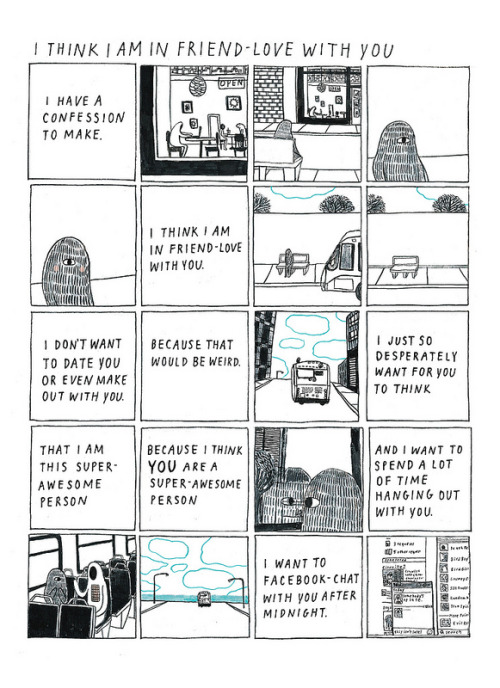
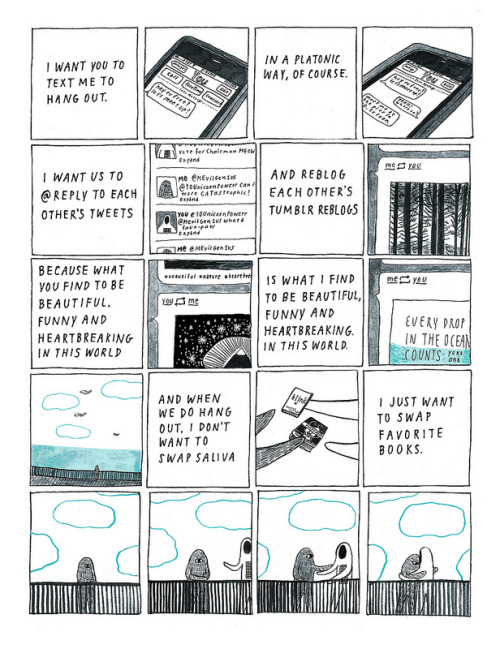
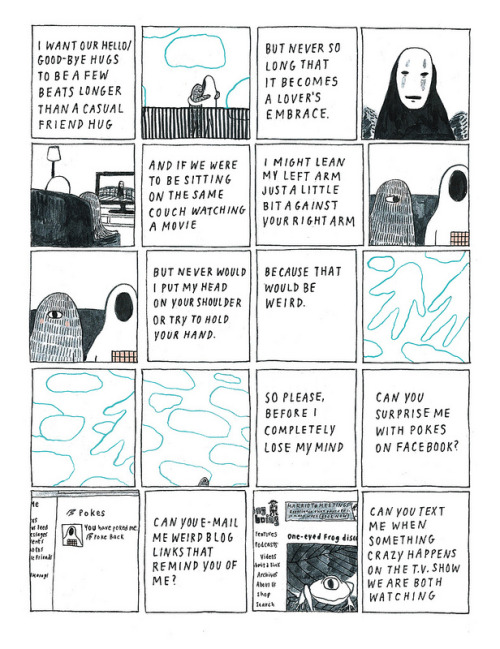
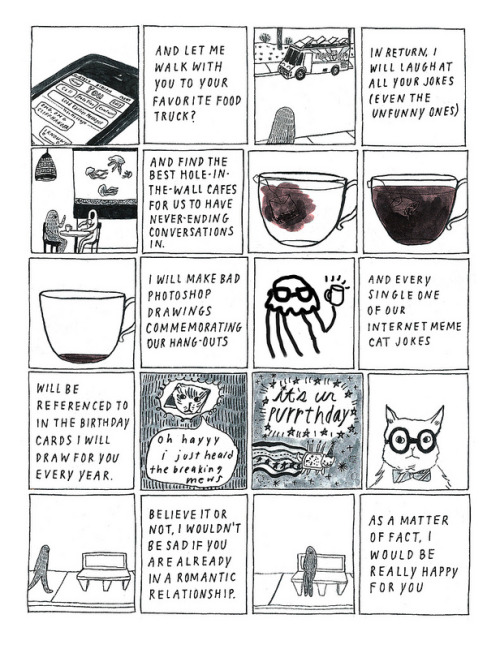
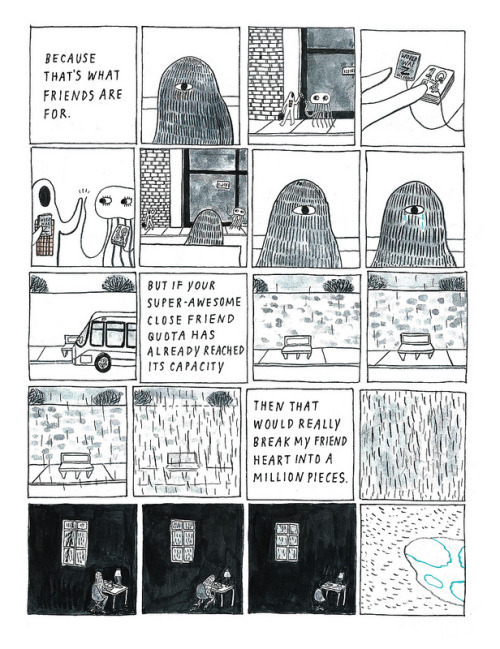
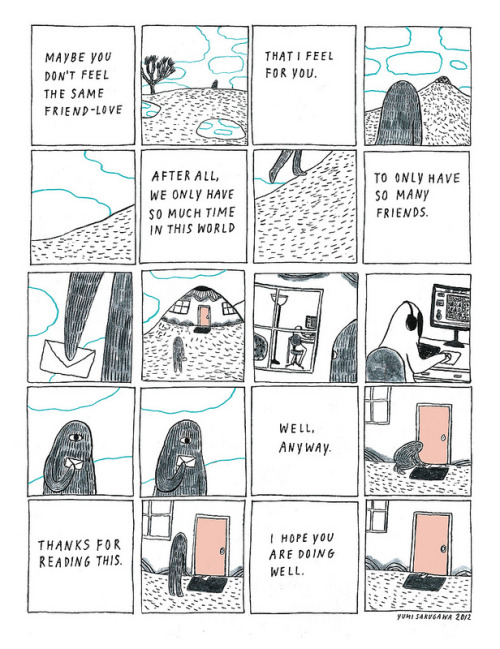
“I Think I Am In Friend-Love With You” written by and illustrated by Yumi Sakugawa, published in Sadie Magazine, 2012.
:’(
how I feel about you, Mim
The DSM-5 has been finalised
 It’s arcane, contradictory and talks about invisible entities which no-one can really prove. Yes folks, the new psychiatric bible has been finalised.
It’s arcane, contradictory and talks about invisible entities which no-one can really prove. Yes folks, the new psychiatric bible has been finalised.
The American Psychiatric Association have just announced that the new diagnostic manual, to be officially published in May 2013, has been approved by the board of trustees.
You can read the official announcement and a summary of the major changes online as a pdf – and it seems a few big developments are due.
The various autism-related disorders have been replaced by a single ‘autism spectrum disorder’ – essentially removing Asperger’s from the manual.
A ‘disruptive mood dysregulation disorder’ has been added to “diagnose children who exhibit persistent irritability and frequent episodes of behavior outbursts three or more times a week for more than a year”.
As the APA admit, this is largely to address the rise of the ‘childhood bipolar disorder’ concept which has led to a huge number of children with challenging behaviour being medicated on rather ill-defined grounds. Whether this actually does anything to change this, is another matter.
Despite the expected revision of the overly complex and often indistinguishable subtypes of personality disorder – these have been kept as they were.
Posttraumatic stress disorder has been tinkered with – apparently to pay “more attention to the behavioral symptoms” and presumably to exclude ‘PTSD after seeing things on the TV’ – a change included in all the drafts.
Perhaps most controversially, the bereavement exclusion will be removed from the diagnosis of depression – meaning you could be diagnosed and treated for depression just two weeks after a loss if you fulfil the diagnostic criteria.
If you want to examine the changes yourself – tough luck – the APA have removed all the proposed criteria off the DSM-5 website. This is supposedly to “avoid confusion” but most likely because the manual is a big money-maker and the finished product will be on sale in May 2013.
But diagnostic developments aside, we can also expect some changes simply from the benefit of hindsight.
Most clinicians will learn enough of the new manual to ensure they look cutting-edge for a few months after publication and then ignore the new diagnoses and use the same ones they’ve always had vaguely stored in their heads.
Researchers will go through an extended period of academic willy waving where they attempt to outdo each other through their wide and extensive knowledge of dull and irrelevant details.
Drug companies will wet themselves in delight at the new opportunities for drug marketing (“Prozac – lighten the mood of losing your mother”).
The APA will keep underlining how we’re now in a new era of science thanks to the science behind the new manual of science that turns everything it touches into pure, definitely not insecure, science.
And finally, the chairman of the DSM-5 committee will begin the traditional process of becoming disillusioned and publicly denouncing each step in the development of the DSM-6.
It’ll be as if the past never happened.
pdf of APA announcement of finalised DSM-5 (via @sarcastic_f)
Link to APA announcement in Psychiatric News.
With More Than 20 of Your Favorite Occult Hits! (Edited and Shortened in Length)
Ninja Bear

Ninja Bear is thankful for his trusty bo-staff!
Pushed Through The Cracks: Transgender Lives And Deaths On The Day Of Remembrance
Crossposted from Open Society Foundations.

The list seems endless.
Deoni Jones, age 23. Stabbed to death in Washington, DC.
Agnes Torres, age 35. Decapitated and thrown in a ditch in Atlixco, Mexico.
Anil Aayiramthengu, age 39. Throat slit in Thangassery, India.
Thapelo Makutle, age 24. Throat slit and mutilated in Kuruman, South Africa.
Barbarita Alemán, age 21. Shot to death in Colonia San Martín, Honduras.
Secil Dilşeker, age 46. Throat slit in Antalya, Turkey.
Sirena Paola, age 44. Beaten to death in Maicao, Colombia.
January Marie Lapuz, age 26. Stabbed to death in New Westminster, Canada.
Rayza Morais Costa, age 18. Bound and shot to death in Belém, Brazil.
Cassandra Zapata, age 39. Strangled to death and burned in Rouen, France.
November 20th is the Transgender Day of Remembrance, when we remember these names among those of the hundreds of other transgender people who were murdered in 2012. According to the Transrespect versus Transphobia Worldwide project, murder took the lives of more than 1,080 transgender people in 56 countries between 2008 and 2012. This number is only the tip of the iceberg, as it includes only the handful of cases that garner media attention.
As the trans scholar and advocate Susan Stryker puts it, many people have difficulty recognizing the humanity of another person if they cannot recognize that person’s gender. As a result, trans people in countries around the world frequently encounter extreme prejudice, harassment, and even murderous violence based simply on who they are.
There have been many different ways throughout history and across cultures of conceptualizing gender and describing the process of negotiating socially determined gender boundaries. Over the last century, the term ‘transgender’ has evolved as a popular umbrella term for people whose gender identity — their internal sense of being a man, a woman, or another gender — or gender expression is different from that typically associated with their birth sex. Some people claim a trans identity, while others are identified as trans on the basis of social definitions of masculine and feminine.
Trans people, like any group of people, come from a wide range of backgrounds. They live in cities and rural areas; are young, elderly, and middle-aged; began to live as their true gender when they were children, young adults, or much later in life; and live in families of all varieties. Trans people, and the communities they live in, are diverse in terms of factors such as race, income, and sexual orientation.
While violence can affect trans people from any background, its patterns are anything but random. The overwhelming majority of the lost trans lives that we honor on the Transgender Day of Remembrance are transgender women of color. Some were immigrants. Many struggled to make a living through sex work and were attacked by clients and police alike. Most were poor. In life and in death, their names and histories hover on the edge of invisibility in societies that accorded them few safe places to call their own.
This invisibility, like the brutality of the violence that claims so many trans people, is a reflection of the pervasive poverty, sexism, and other forms of systematic exclusion that circumscribe trans lives. Transgender people routinely confront institutionalized discrimination in areas of everyday life such as health care, housing, employment, education, and legal recognition in their true gender.
Anti-trans discrimination in health care is a particularly cruel reality, since many trans people need transition-related medical services to fully embody their true selves. And even while seeking the same basic health care that anyone might need to fix a broken bone or treat the flu, trans people frequently encounter biased and inadequate treatment from health care providers and denials of financial support from national health systems and health insurance programs.
The consequences of discrimination in health care are deadly. Transgender people are not only disproportionately likely to be victims of violence: They are also more likely to contract HIV, to go without preventive care that can catch diseases like cancer early, and to attempt suicide. In a recent study of more than 6,400 transgender people in the United States, for example, 41 percent of trans people reported attempting suicide — a rate 25 times higher than the general population.
Across the world, trans people are being excluded from jobs, turned away by doctors, funneled into prisons, and left to die by the side of the road. They are not slipping through the cracks: Indifference, hatred, and violence are actively forcing them down through the gaps in our social safety nets, our health care systems, and the legal systems of citizenship by which our societies determine whose lives matter.
The thousands of trans people whom we remember this November 20th must rely on the living to seek their justice. Fortunately, trans activists and their allies in countries across the globe are fighting to end the violence and invisibility that erase trans lives and advocating for policies that respect gender diversity and the full human rights of trans people.
A forthcoming report from the Sexual Health and Rights Project at Open Society Foundations, Transforming Health: International Rights-Based Advocacy for Trans Health, provides snapshots of 16 trans health and rights initiatives from 9 countries and the World Health Organization. The report makes recommendations across fields such as health care, data collection, and government identity document policies that we hope can help build a world in which there are no new names to read out at the Transgender Day of Remembrance. Until then, we must not only work for justice here and now — we must pause this November 20th and remember our dead.
Deoni, Agnes, Anil, we remember you. Thapelo, Barbarita, Secil, we remember you. Sirena, January, Rayza, Cassandra, and so many others — you will remain forever in our hearts.
 |
 |
The S&M election

(Credit: Mr. Fish)
I learned at the age of 10, when I was shipped off to a New England boarding school where the hazing of younger boys was the principal form of recreation, that those who hunger for power are psychopathic bastards.
The bullies in the forms above me, the sadistic masters on our dormitory floors, the deans and the headmaster would morph in later life into bishops, newspaper editors, college presidents, politicians, heads of state, business titans and generals. Those who revel in the ability to manipulate and destroy are demented and deformed individuals.
These severely diminished and stunted human beings —think Bill and Hillary Clinton — shower themselves, courtesy of elaborate public relations campaigns and an obsequious press, with encomiums of piety, patriotism, devoted public service, honor, courage and vision, not to mention a lot of money. They are at best mediocrities and usually venal. I have met enough of them to know.
So it is with some morbid fascination that I watch Barack Obama, who has become the prime “dominatrix” of the liberal class, force us in this election to plead for more humiliation and abuse. …
The only recognizable basis for moral and political authority, in the eyes of the elite, is the attainment of material success and power. It does not matter how it is gotten. The role of education, the elites believe, is to train us vocationally for our allotted positions and assure proper deference to the wealthy. …
Disciplines that prod us to think are — and the sneering elites are not wrong about this — “political,” “leftist,” “liberal” or “subversive.” And schools and universities across the country are effectively stomping out these disciplines. The elites know, as Canetti wrote, that once we stop thinking we become a herd. We react to every new stimulus as if we were rats crammed into a cage.
When the elites push the button, we jump. It is collective sadomasochism. And we will get a good look at it on Election Day.
(More)
INFOGRAPHIC: Trans Community Faces Unique Health Disparities
Transgender Awareness Week continues today in the lead-up to tomorrow’s observation of the International Transgender Day of Remembrance. Fenway Health has developed an infographic to highlight various health inequities that transgender people experience, including lacking access to health insurance, being denied care because of their identities, and facing higher rates of depression, substance abuse, and HIV infection. View it below, or share it on Facebook or Tumblr:
 |
 |
Trans Woman Fights Charges She’s A Danger To Her Son
Jessica Lynn, a trans woman living in California, is fighting for the right to see her son. When she separated from her wife, her ex (now living in Texas) was supportive of her transition, but that changed when Lynn said she wanted to talk about it with their 13-year-old son. The ex filed a temporary restraining order preventing Lynn from informing their son about her transition because it would have an “irreparable” emotional impact and be “dangerous to [his] mental health and emotional well-being.” There is nothing to substantiate such claims, but Texas does not have much case law on custody and transgender parents, so biases could influence the results.
 |
 |
Maker Faire Africa 2012: Lagos, in Pictures
As one of the founding organizers for Maker Faire Africa, I’ve had the privilege to be a part of this unfolding maker movement in Africa. To be honest, it’s been going on for a while, so I guess what we’re really doing is just aggregating it in a country, and shining a spotlight on some of the great practical innovation on the continent.
Maker Faire Africa 2012 in Pictures from WhiteAfrican on Vimeo.
Just to get a feel for the projects and people at Maker Faire Africa in Lagos this year, I put together this video with pictures from my phone. I have some more images up on Flickr.
I’ve been blogging most of this on the Maker Faire Africa blog, so go there to find more posts on the stories from Lagos, Nigeria and the innovative and fun products made there.
















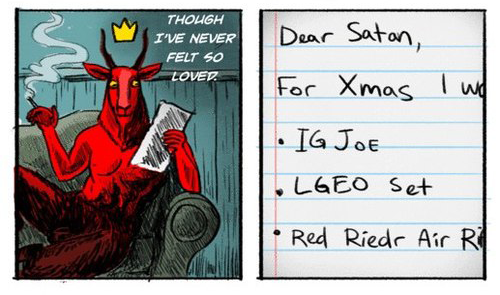

 facebook
facebook  reddit
reddit 








